Building of the Day: 70 Hudson Avenue
Brooklyn, one building at a time. Name: Storefront and residential building, now home to Hillside Cafe Address: 70 Hudson Avenue Cross Streets: Corner Water Street Neighborhood: Vinegar Hill Year Built: 1828-1841 Architectural Style: Greek Revival Architect: Unknown Landmarked: Yes, part of Vinegar Hill HD (1997) The story: The Vinegar Hill neighborhood sandwiched between industrial Dumbo,…

Brooklyn, one building at a time.
Name: Storefront and residential building, now home to Hillside Cafe
Address: 70 Hudson Avenue
Cross Streets: Corner Water Street
Neighborhood: Vinegar Hill
Year Built: 1828-1841
Architectural Style: Greek Revival
Architect: Unknown
Landmarked: Yes, part of Vinegar Hill HD (1997)
The story: The Vinegar Hill neighborhood sandwiched between industrial Dumbo, the huge Con Ed facility and the Farragut Houses, is one of Brooklyn’s oldest neighborhoods. The landmarked areas of the neighborhood present a time capsule into Brooklyn’s past, one more intact than almost any other part of town. Narrow cobblestone streets wind around the area, and on those streets are a collection of houses, storefronts and businesses that go back to the early days of the ever-growing town of Brooklyn.
Vinegar Hill got its name from late 18th century developer and landowner John Jackson, who named it after a bitter battle in the Irish rebellion against the British in 1798. The Irish rebellion was crushed at the time, and the Battle of Vinegar Hill was the last battle of the conflict. In the early 19th century, many of the Irish displaced by the war began to immigrate to New York and settled in this area.
Jackson, along with the Sands brothers, owned and developed most of the land in the area. Jackson owned over 100 acres, which he had bought from the Remsen family after the Revolutionary War. His land spread out from Wallabout Bay, and included parts of Clinton Hill, Fort Greene, Downtown and the Vinegar Hill area. He was also a shipbuilder, building homes for his workers near his shipyards that he sold to the U.S. government in 1801, on order to create the Brooklyn Navy Yard.
He and his descendants began building in the Vinegar Hill area as early as 1810. Vinegar Hill soon filled with buildings with storefronts on the ground floors, as well as more traditional brick or wood framed row houses in the clean lined and simple Federal and Greek Revival styles. The storefronts were taken up by grocers, taverns and other shops, all providing their wares to a rapidly growing workforce that worked in the nearby Navy Yard, as well as in the growing number of factories and warehouses in the Wallabout and Dumbo area.
This building was begun in 1828, by either John Jackson or his heirs. This is the year that the block was divided into lots. The first residents show up in city records in 1841. A grocer named Patrick Waters was the first listed occupant. The building changed hands five times between 1844 and 1860, when it was purchased by grocer Schutte. It was he who built the apartment building at its rear, now 312 Water Street. He lived here in 1870, and there were fourteen occupants in three households in the 1880 census. In 1912, the Societa Coopertiva Degli Italiani in America owned the building, and they lowered the first floor, and changed the appearance of the storefront.
By 1938, when tax photos were taken, the storefront was boarded up, although the house was still occupied. We can see there used to be a raised entrance to the residential part of the building, and the original clapboard is visible. In 1996, when the property was photographed for landmarking, the storefront had been further altered, and not well, either, and the building entrance lowered.
Now fast forward to 2007, and the Property Shark photo, which shows the same façade as in 1996, albeit cleaned up considerably. In 2011, the storefront became home to Hillside, an upscale café and wine bar owned by the Vinegar House Restaurant, which is next door. The entire building got a facelift, new doors and entrance to the residential part of the building, and a brand new storefront, which harkens back to the original. The café is very well done with reclaimed materials. John Jackson would be surprised to see the old neighborhood. GMAP
(Photo above: DumboNYC, 2011, before renovation)
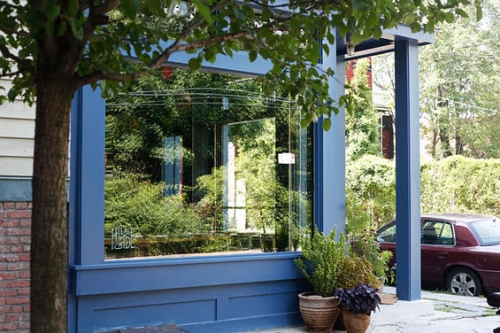
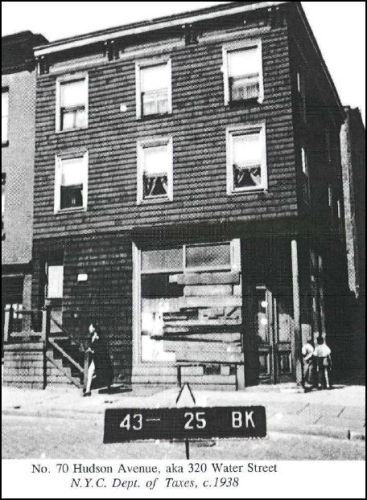
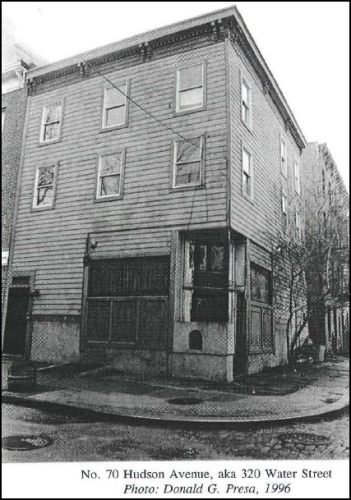
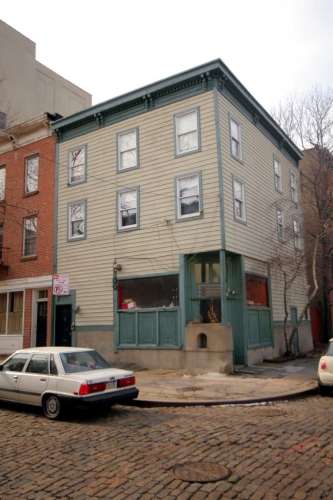

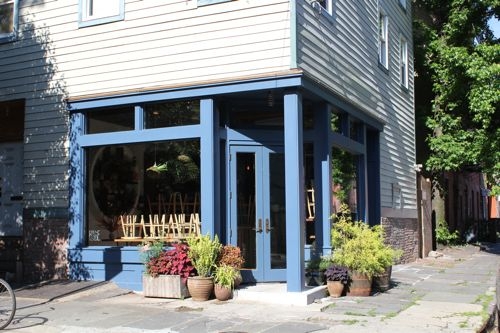




What's Your Take? Leave a Comment